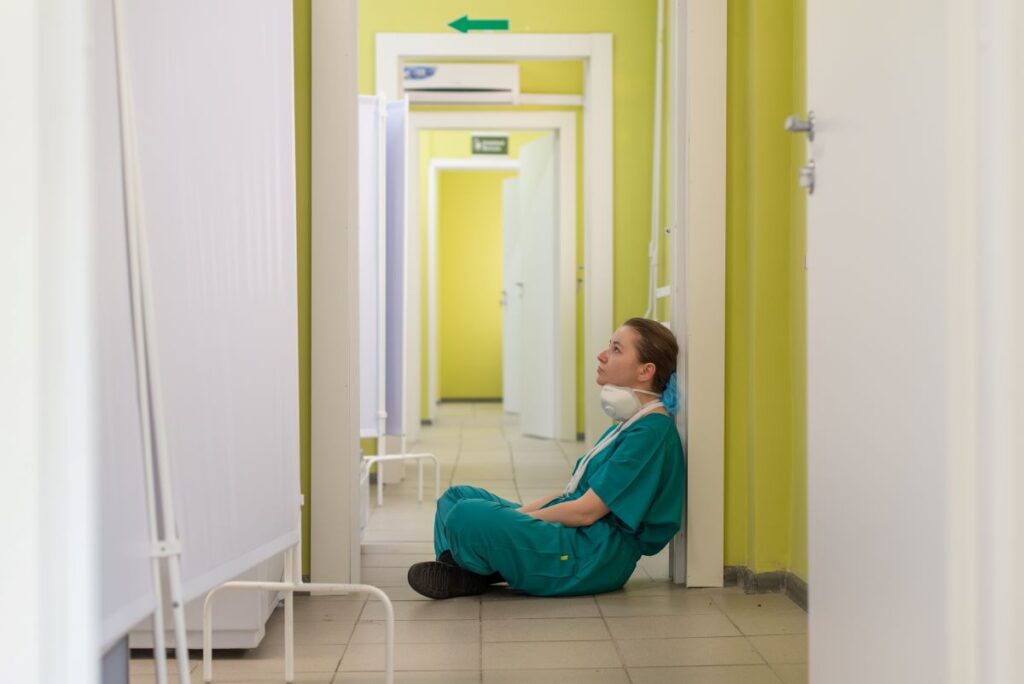
“No one ever told me that grief felt so like fear” – CS Lewis.
The literature on PTSD after natural disasters and pandemics, is extensive (Cesar 2018). By no exception, COVID-19 has sustained its harrowing impact and the ripple effects of its presence will, unfortunately, be seen in years to come. Despite the modern innovation and advancement of biomedical wisdom, the pandemic has pierced through the veil of infection control armoury. COVID-19 has become the invisible enemy mostly witnessed by healthcare workers.
UK frontline health care workers (FHCWs) have had to work with infected patients, and at times watch patients or fellow colleagues succumb to the virus. One can only imagine listening to the bleeping machine and the sounds of the ventilating machines ebbing away, as another life is mercilessly snatched away.
Studies have already indicated that working in frontline roles in health care services during the COVID-19 pandemic has taken a toll on FHCWs (Ramkumar 2020). The traumatic experiences of the effects of COVID-19 have led to reports of depression, anxiety and other mental illnesses. Stress and psychological factors are reported as the primary concerns for nurses during the COVID-19 pandemic (Pappa et al 2020).
This study by Greene et al. aimed to identify predictors for clinical post-traumatic stress disorder (PTSD), anxiety and depression and to compare rates of distress across different groups of FHCWs in various roles and settings.

Frontline healthcare workers have reported increases in depression and anxiety as a result of the COVID-19 pandemic.
Methods
A total of 1,194 FHCWs completed an online survey during the first week of the pandemic breakout. The FHCWs areas of work included, but were not limited to, NHS hospitals, private care homes and community settings. The following tools were utilised:
- Trauma – International Trauma Questionnaire
- Depression – Patient Health Questionnaire
- Anxiety – Generalised Anxiety Disorder Syndrome- GAD-7
Results
The mean age of the respondents was 41.5 years old and the majority of the sample was female (92.4%). Of the responses provided, 58% met the clinical threshold for either PTSD, depression or anxiety; 22% were identified to have PTSD, 47% were deemed to be experiencing depression and 47% were also identified as having anxiety.
Clinical support staff reported more symptoms across all three disorders than allied health professionals, and also participants working in nursing or care home settings had higher levels of PTSD symptoms when compared with other community settings.
Three variables significantly predicted distress:
- Being able to tell their manager if they’re not coping
- Being worried about infecting others
- Perceived stigma.
There were also a number of significant predictors of disorders:
- Not having had reliable access to personal protective equipment was associated with anxiety and depression
- Having been redeployed during COVID-19 was associated with PTSD
- Nurses and midwives were more likely to experience PTSD than carers and clinical support staff. They were more likely than allied healthcare professionals, carers and ‘other roles’ to meet criteria for any clinically significant disorder
- Being worried about being infected was associated with PTSD
- Having had COVID-19 was associated with increased odds of meeting criteria for any clinically significant disorder
- The group with the highest income were least likely to meet criteria for PTSD and anxiety, and had lower odds for any clinically significant disorder.

Almost two thirds of frontline healthcare workers met the criteria for at least one disorder, including PTSD, anxiety and depression.
Conclusions
Examining and evaluating the impact of the COVID-19 pandemic on the mental health of frontline healthcare workers (FHCWs) was the main priority in the study. This helped to identify the actual nature of the risks faced by FHCWs and guide future ways to support these individuals who often face unique challenges. The study concludes that identifying risk factors for PTSD, depression and anxiety among healthcare workers, and providing treatment for those who need it, is critical in facing a pandemic as dynamic as COVID-19.

We need to focus on the health and wellbeing of frontline healthcare workers. Finding ways to support them, especially with the involvement of leadership, is deemed crucial in fighting the pandemic.
Strengths and limitations
Strengths
The study provided a robust background into the characteristics of the individuals taking part in the survey carried out.
The scales used to test anxiety, PTSD and depression were of varied parameters hence providing different levels of understanding the experiences of COVID-19.
Limitations
The lack of data on ethnicity and its possible impact appear to narrow the discussion on the predictor variables.
Mbiba et al (2020), in their extensive research on the impact of COVID-19 on BAME healthcare workers, concluded that the experiences for disadvantaged BAME health and social workers would not be fully understood. This was due to the fact that they had limited or non-existent access to the management teams and other senior hierarchical position holders. It would have been interesting to identify the personal individual experiences of COVID-19 from a socio-cultural perspective.
The research should have also focussed more on other FHCWs, for instance roles such as porters and cleaners. Their experience, though without any consistent contact with the patients, would have been crucial to increase the inclusiveness of opinions in the research. A story by Peter Jinks (London Hospital Porter concludes, “Behind them (doctors and nurses), we’re the midfield that keeps everything moving” (The Guardian Newspaper, May 2020). In light of the above, an attention to the other side of relevant experience would have possibly reinforced and established a weighty argument to the research findings.
The participants were provided with email questionnaires. This would have been deemed appropriate and necessary in hindsight of the COVID-19 pandemic. The questionnaires comprised of questions requiring self-selection choices and responses. This can lead to potential bias and influence the validity of the results as people are more likely to offer unbiased responses when interviews are done by physical face-to-face meetings (Eysenbench and Wyatt, 2002).

This study helps to give a wider understanding of the experiences of frontline healthcare workers during the pandemic. However, the study could have been improved by including a more diverse set of experiences in the research.
Implications for practice
The temptation is to rush to put in place short term remedies. The recent 1% increase in nurses’ pay by the government appears to demonstrate a lack of awareness into the challenges experienced by FHCWs. There is a need for the government to help heal the wounds sustained as a result of the pandemic. In doing this, leadership and management healthcare sectors are required to play a positive role to give crucial support to FHCWs and reduce stress. If ever there was a need to be refocussed on the importance of human connection and interpersonal reliance, the COVID-19 pandemic is that time.

It remains fundamental to consider the devastating impact and input of everyone involved in the healthcare sector, regardless of class or identity.
Statement of interests
None to declare.
Links
Primary paper
Greene T, Harju-Seppänen J, Adeniji M, Steel C, Brewin C, Grey N. (2021). Predictors and rates of PTSD, depression and anxiety in UK frontline health and social care workers during COVID-19. European Journal of Psychotraumatology
Other references
American Psychiatric Association. (2013). Diagnostic and statistical manual of mental disorders (5th ed.). Arlington, VA: American Psychiatric Publishing.
Cesar, A. (2018). PTSD and Suicide After Natural Disasters. Psychiatric Time. Vol 35 No 4, Volume 35
Eysenbach, G., and Wyatt, J (2002). Using the internet for Surveys and Health Research. Journal of Internet Research Vol 4 JMIR Publications Toronto
Jinks, P. (2020). A porter’s story: ‘The hospital in Covid-19 times reminds me of a disaster movie’ The Guardian Newspaper, London
Mbiba, B., et al. (2020). At the deep end: COVID-19 experiences of Zimbabwean health and care workers in the United Kingdom. Journal of Migration and Health. Volume 1-2, 2020.
Pappa, S., et al. (2020). Prevalence of Depression, Anxiety, and Insomnia among Healthcare Workers during the COVID-19 Pandemic: A Systematic Review and Meta-Analysis. Brain, Behavior, and Immunity, 88, 901-907.
Ramkumar, S. (2020). Analysing the Impact of COVID-19 on Frontline Workers Using Machine Learning
Photo credits
- Photo by Bermix Studio on Unsplash
- Photo by Vladimir Fedotov on Unsplash
- Photo by Gift Habeshaw on Unsplash
- Photo by Gabriel Bassino on Unsplash
- Photo by Gil Ribeiro on Unsplash
- Photo by Ehimetalor Akhere Unuabona on Unsplash
